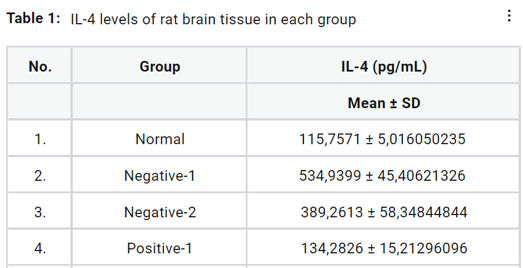The Effect of the Administration of Salam Leaf Ethanol Extract on IL-6 and IL-4 on Benzene-Induced Brain Networks of Rats
Abstract
Benzene is poisonous to the human body and has been linked to neuro-toxic and neurodegenerative illnesses. Bay leaf is extremely safe to consume because it has been shown in experimental animals to have no toxic, teratogenic, or genotoxic effects and to have a strong antioxidant effect. The purpose of this study is to assess the neuroprotective impact of an ethanolic extract of bay leaf on rats exposed to benzene. The study was divided into 11 groups: group 1 was assigned to a control condition, groups 2 and 3 were assigned to negative controls, groups 4 and 5 were assigned to positive controls, and groups 6-11 were assigned to receive an ethanol extract of bay leaf. For 21 days, benzene was injected intraperitoneally every three and six days and the extract was delivered orally. On day 22, rats were sedated and their brains were collected and examined for IL-4 and IL-6 levels using an Elisa kit and a 450 nm microplate reader. The results indicated that the levels of IL-4 and IL-6 increased statistically substantially in rats given just benzene (p0.05), whereas they decreased in animals given the highest extract, 800 mg/kg BW. The levels of IL-4 and IL-6 were not statistically significantly different from those in the normal group (p>0.05). Thus, it can be inferred that the ethanolic extract of bay leaves has a neuroprotective effect due to the presence of flavonoids that contribute to the prevention of inflammation caused by benzene exposure.
Full text article
References
B J Lee, B S Kim, and K H Lee. Air Pollution Exposure and Cardiovascular Disease. Toxicological Research, 30(2):71–75, 2014.
Ali, Susanti D, K Fenditasari, Z Jannah, W Usiana, and S Indartono. Natural coagulant of laban wood (Vitex pubescens Vahl) for turbidity water treatment. InIOP Conference Series: Earth and Environmental Science, 344(1):12042–12042, 2019.
J B Harris and A Goonetilleke. Animal poisons and the nervous system: what the neurologist needs to know. Neurosurgery & Psychiatry, 75(Supple 3):40–46, 2004.
WHO. COP24 special report: health and cli- mate change. World Health Organization, pages 73–73, 2018. ISBN: 9789241514972.
D Bayliss, J Jinot, and W B Sonawane. Toxicological Review of Benzene (Non-Cancer Effects). pages 1–180, Washington, D.C, 2002. EPA-U.S.Environmental Protection Agency.
R L Pumo, M Bellia, A Nicosia, V Micale, and F Drago. Long-lasting Neurotoxicity of Prenatal Benzene Acute Exposure in Rats. Toxicology, 223(3):227–234, 2006.
R Hasan, D Lindarto, G A Siregar, and Z Mukhtar. The Effect of Salam Leaf (Syzygium polyanthum [Wight] Walp.) Extract on Inflammation in Rat Model of Acute Coronary Syndrome. Open Access Macedonian Journal of Medical Sciences, 8(A):374–377, 2020.
I D Dewijanti, N Artanti, W Mangunwardoyo, M Hanafi, J Abbas, M Megawati, M Minarti, D Musdalifah, and L Meilawati. Bioactivities of Syzygium polyanthum (Wight) Walp leaf extract for decreasing diabetic risk. InAIP Conference Proceedings, 2024(1):20011–20011, 2018. AIP Publishing LLC.
A Anggraini. Benefits of Bay Leaf Antioxidants Against Blood Glucose Levels and Decreased Neuron Apoptosis in the Hippocampus of Diabetic Rat Brains. Jurnal Medika Hutama, 2(1):349–355, 2020.
Y S Pratiwi, R Lesmana, H Goenawan, N Syl- viana, I Setiawan, V M Tarawan, K Lestari, R Abdulah, L Dwipa, A Purba, and U Supratman. Nutmeg extract increases skeletal muscle mass in aging rats partly via IGF1-AKT- mTOR pathway and inhibition of autophagy. Evidence-Based Complementary and Alternative Medicine, 2018. Article ID 2810840.
A M Emaram and H El-Bahrawy. Green Tea Attenuates Benzene-Induced Oxidative Stress in Pump Workers. J.Immunotoxicol, 5(1):69– 80, 2008.
L A Wallace. The exposure of the general population to benzene. Cell biology and toxicology, 5(3):297–314, 1989.
MD Ribeiro Da Silva, O Mó, M Yáñez, J Elguero, M V Roux, P Jiménez, J Z Dávalos, P Cabildo, and R Claramunt. Substituent effects on enthalpies of formation: benzene derivatives. The Journal of Physical Chemistry A, 107(3):366–371, 2003.
D Litteljohn, E Mangano, M Clarke, J Bobyn, K Moloney, and S Hayley. Inflammatory Mechanisms of Neurodegeneration in Toxin-Based Models of Parkinson’s Disease. Parkinson’s Disease-Hindawi, 2011.
H Rivai, H Andi, and F humaira. Preparation and Characterization of Bay Leaf Dried Extract (Syzigium polyanthum (Wight) Walp.). Jurnal Farmasi Higea, 7(1):54–62, 2015.
P S Widyawati. Determination of antioxidant capacity in Pluchea indica Less leaves extract and its fractions. International Journal of Pharmacy and Pharmaceutical Sciences, 8(9):32– 36, 2016.
A S Ramadhana, N Marcelino, E C Clara, K I Fauhan, and I N Lister. Comparison of effective- ness of basil leaves ethanol extract with garlic on Staphylococcus aureus bacteria. Biospecies, 13(1):8–14, 2020.
A Ismail, N K Kassim, P C Lim, and K Awang. Isolation of antioxidative compounds from Micromelum minutum guided by preparative thin layer chromatography-2, 2-diphenyl- 1-picrylhydrazyl (PTLC-DPPH) bioautography method. Food chemistry, 272:185–191, 2019.
Authors

This work is licensed under a Creative Commons Attribution-NonCommercial-NoDerivatives 4.0 International License.





